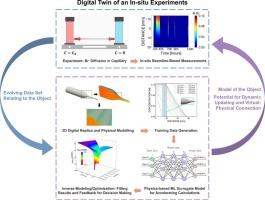走向原位实验的数字孪生:用于质量传输过程逆建模的物理增强机器学习框架
IF 6.3
1区 地球科学
Q1 ENGINEERING, CIVIL
引用次数: 0
摘要
作为实验地球化学概念的验证,一个先进的3D数值框架,称为数字孪生(DT),在同步加速器光束线上进行的扩散实验,已经使用现场测量数据,基于物理的建模,机器学习(ML)模型和参数优化模块实现。基于物理的模型可以实现精细离散的高分辨率3D质量传输模拟,为ML模型提供训练集。由此产生的ML模型大大加快了在逆建模期间解释实验观测所需的计算密集型计算。将该框架应用于通过硅胶填充毛细管系统对溴化物扩散实验的原位无损微x射线荧光(μ-XRF)成像数据的解释。对计算框架进行了细化,并实现了几种优化算法来拟合实验数据。在计算效率的增益允许模拟实际的实时实验。本文章由计算机程序翻译,如有差异,请以英文原文为准。

Towards digital twin of an in-situ experiment: a physics-enhanced machine-learning framework for inverse modelling of mass transport processes
As a prove of concept for experimental geochemistry, an advanced 3D numerical framework, here and after called Digital Twin (DT), of a diffusion experiment conducted at a synchrotron beamline, has been implemented using in-situ measurements data, physics-based modelling, a machine learning (ML) model, and parameter optimization module. The physics-based model enables finely discretized high-resolution 3D mass transport simulations, which provide the training set for the ML model. The resulting ML model greatly accelerates the computationally intensive calculations needed for the interpretation of the experimental observations during inverse modelling. The framework is applied to interpret the in-situ non-destructive micro-X-ray fluorescence (μ-XRF) imaging data from a bromide diffusion experiment through a silica-gel-filled capillary system. The computational framework is refined, and several optimization algorithms are implemented to fit the experimental data. The gain in computational efficiency allows modelling the experiment practically in real-time.
求助全文
通过发布文献求助,成功后即可免费获取论文全文。
去求助
来源期刊

Journal of Hydrology
地学-地球科学综合
CiteScore
11.00
自引率
12.50%
发文量
1309
审稿时长
7.5 months
期刊介绍:
The Journal of Hydrology publishes original research papers and comprehensive reviews in all the subfields of the hydrological sciences including water based management and policy issues that impact on economics and society. These comprise, but are not limited to the physical, chemical, biogeochemical, stochastic and systems aspects of surface and groundwater hydrology, hydrometeorology and hydrogeology. Relevant topics incorporating the insights and methodologies of disciplines such as climatology, water resource systems, hydraulics, agrohydrology, geomorphology, soil science, instrumentation and remote sensing, civil and environmental engineering are included. Social science perspectives on hydrological problems such as resource and ecological economics, environmental sociology, psychology and behavioural science, management and policy analysis are also invited. Multi-and interdisciplinary analyses of hydrological problems are within scope. The science published in the Journal of Hydrology is relevant to catchment scales rather than exclusively to a local scale or site.
 求助内容:
求助内容: 应助结果提醒方式:
应助结果提醒方式:


